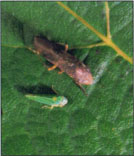All Issues
Sharpshooter on the move
Publication Information
California Agriculture 54(3):4-4.
Published May 01, 2000
PDF | Citation | Permissions
Full text
Despite efforts to contain the glassy-winged sharpshooter in Southern California, it has been popping up recently in different locations around Northern and Central California, stirring fears of the dreaded Pierce's disease.
On June 9, the California Department of Food and Agriculture designated Fresno and Tulare counties as infested with glassy-winged sharpshooter (GWSS). Any shipments of GWSS-regulated nursery stock from Fresno and Tulare counties must meet the entry requirements of the receiving county.
Sharpshooters spread the bacterium Xylella fastidiosa, which causes Pierce's disease. Pierce's disease kills vines by clogging the plant's water-conducting tissues. Over the past three growing seasons, the disease has killed more than 300 acres of vineyards in the Temecula Valley and threatens the survival of Riverside County's viticulture and wine industries.
GWSS is a serious threat to California vineyards because it travels longer distances, penetrating farther into vineyards than other sharpshooter species. Its larger mouthparts allow it to feed on older wood.
Four GWSS infestations have been found in residential areas of Fresno County. Richard L. Coviello, Fresno County entomology advisor, thinks GWSS has been in Fresno for at least a year because an amateur entomologist had a specimen in his insect collection that he collected last year, and based on the abundance of insects and the fact that they've found old egg masses and even parasitized egg masses.
GWSS egg masses have turned up in Alameda, Napa, Sonoma, Lake and San Luis Obispo counties on shipments of ornamental plants from Southern California. In Napa, where only old and parasitized egg masses were found, the Board of Supervisors is moving to adopt a local ordinance restricting the movement of nursery stock and harvested fruit from any infested county.
Gov. Gray Davis signed legislation providing $6.9 million to fight GWSS. An additional $6.9 million is expected to be added next year. Congress is making $7.14 million available to protect California crops from GWSS.
For more information about Pierce's disease, see the Web site: http://danr.ucop.edu/news/speeches/PDcontents.html





